Dishwashers are either hardwired or plugged into an outlet. While most people use the former, some prefer the latter but don’t know how to go about it.
In this article, we’ll be discussing the type of outlet that is suitable for a dishwasher and explaining the requirements for setting it up. We’ll also teach you how to convert a hardwired dishwasher to a plug-in.
Can You Plug a Dishwasher into a Regular Outlet?
You can plug a dishwasher into a regular outlet, as long as it meets the requirements of a dishwasher outlet. The standard outlet for most homes is a 15 amps outlet. And this is enough to power your dishwasher.
Though some dishwashers are 20 amps and require outlets and circuit breakers with 20 amps, they are rare. So if your outlet is the regular 15 A outlet, you are good to go.
Note that while the outlet may work perfectly for your dishwasher and give no problems, it may not be code compliant. You can use it temporarily until you make a suitable outlet that is code compliant for your dishwasher.
In the next heading, we’ll be talking about dishwasher outlet requirements so you know what we are talking about. And if you have an outlet in your kitchen that fits the bill already, then you are lucky.
Dishwasher Outlet Requirements
1- Accessibility
The dishwasher outlet should be located in a place you have easy access to so that you can turn the power on and off without stress.
It shouldn’t be behind the dishwasher as the dishwasher will need to be moved every time you want to turn the appliance on or off which can be dangerous.
You can fix it under the sink or the adjacent cabinet to the dishwasher.
2- Correct amps
Your dishwasher outlet should be at least 15 amps. This is the standard for most dishwashers. If your dishwasher draws more than this, maybe 20 amps, it will be indicated so that you can get a 20 amps outlet.
The circuit breaker should also be according to this. Use a 15 amps or 20 amps circuit based on the outlet amps. And this circuit should be monopolized for the dishwasher. It means nothing else should be plugged into the outlet to prevent problems.
3- Gfci Outlets Are Preferable
Ground fault circuit interrupter outlets provide extra security and prevent problems. The outlet will trip or disconnect the power supply when the outlet gets wet to avoid electrocution.
Sometimes, this is mandated where the outlet for the sink is placed close to the sink or in an area in the kitchen where it’s likely to get wet. In some states, it’s not an option.
If you aren’t sure of the code in your area, then you should use it. Ensure the outlet has the correct amps and circuit.
What Type of Plug Does a Dishwasher Use?
1- The power cord and plug you get for your dishwasher must have the same voltage as your dishwasher. Usually, dishwashers are 120V but in rare cases, some dishwashers are 240V.
You should check and be certain before getting a plug. To check, disconnect the power supply of the dishwasher, open the gang box of the thermostat and check the wires in it.
If you see black and white wires, your dishwasher is 120V, if you see black and red wires, your dishwasher is 240V. If it’s a new dishwasher and you still have the manual, you don’t need to go through this stress, it should be written inside.
2- The power cord and plug have to have the same amps as the dishwasher or more. Most dishwashers have a 15 amps rating but in rare cases, you see one with 20 amps.
You shouldn’t get a cord that is less than 15 amps for your dishwasher. And it should be a 3 prong plug.
3- The wire of the power cord and plug should be a 12- gauge size. 14- gauge wires cannot transmit enough current to the dishwasher and this can cause problems.
The plug has to have enough watts for the dishwasher too. The space between the dishwasher and outlet should also be considered, you don’t want something too short or too long.
Where to Install an Outlet for a Dishwasher?
You can install your dishwasher outlet anywhere you like in the kitchen, as long as;
1- They are not more than 6 feet away from the dishwasher. Some state codes might not even allow cords that are that long. So ensure the outlet is fixed close to the dishwasher.
2- They are accessible. You have to be able to get to it easily without moving your dishwasher.
If your dishwasher is in a space in your cabinet, the recommended place for an outlet is the space adjacent to/beside the dishwasher.
Cut a hole through the side and pass the power cord through. Then install an outlet that the power cord can attach to.
Are Most Dishwashers Plugged in or Hardwired?
Most dishwashers are hardwired. They come with electrical boxes that have wires that can be connected to electric circuits in the home located in the same space occupied by the dishwasher.
You just connect the wires from the dishwasher to the ones coming out of the wall together with wire nuts.
Since dishwashers last for a long time and do not often need to be replaced, a permanent connection is preferred which is why people go for hard wiring. They are also safer and made compulsory in some states.
If you prefer plugged-in dishwashers, and the dishwasher brand you like only makes hardwired ones, that’s not a problem. Hardwired dishwashers can be changed to plugged-in and vice versa. So it all depends on your preference and the installation code in your state.
Reasons Not to Hardwire a Dishwasher
1- It is difficult to install: If your home doesn’t have any previous wiring meant for a dishwasher, doing that will be stressful. You may not be able to do it yourself if you have no previous electrical knowledge, and hiring a professional to do it will cost you more.
Moving your dishwasher to a new place will also be difficult. If it’s plugged in, you can just remove the plug, move the dishwasher to a new place or home and just plug it into another outlet that is suitable for the dishwasher. But for hardwired dishwashers, it’s not that simple.
2- Moving or pulling the appliance will be difficult: You can’t move the dishwasher more than the wires allow and the wires are usually short.
If you move the dishwasher too much, you risk electrical damage. Whatever work you need to do around the dishwasher will have to be done after the dishwasher has been disconnected.
For example, if you want to install tiles under your dishwasher, if it is plugged in, you just have to remove the cord and move the dishwasher out. Then move it back after the installation. All this can be done yourself.
Hardwired ones however are different. If you do not know about wiring, an electrician will have to help you disconnect the dishwasher and connect it back after the tile installation. This wastes time and money.
How Are Hardwired Dishwashers Converted to Plug-Ins?
You bought a hardwired dishwasher and want to convert it to a plug-in that uses an outlet? or you have been using your dishwasher hardwired but want to start using it as a plug-in?
It’s simple and you can even do it yourself if you follow the easy steps explained below:
YOU’LL NEED
1- Plier
2- Dishwasher power cord kit
3- Outlet
4- Nails (to attach outlet to the wall)
5- Screwdriver
STEPS
STEP 1: Turn off the dishwasher at the circuit breaker. Ensure there’s no power going to the dishwasher. You don’t want to get hurt or die. Your safety should always be your priority because you’ll be doing some electrical work.
STEP 2: If the dishwasher has already been hardwired, pull it out a bit and take a look at the back. You will see where the wire from the wall enters the dishwasher. You will see a clamp holding that wire in place. Loosen the clamp a bit with a plier.
STEP 3: Now go to the front of the dishwasher. There’s a cover plate at the bottom of the dishwasher. Use a screwdriver to loosen and remove the screws on it and remove the plate. Put the screws somewhere safe.
STEP 4: Removing the cover plate on the dishwasher will help you access the junction box inside. The junction box will have a screw on it. Remove this screw and put it somewhere safe.
STEP 5: Remove the box and you’ll see where the wires from the dishwasher and the house meet.
The white wire from the wall is connected to the white wire from the junction box, the black wire from the junction box is connected to the black wire from the wall, and the ground wire from the wall is connected to the ground screw on the junction box.
STEP 6: Remove the wire nuts that cover where the wires meet. After removing the wire nuts, detach the wires and free them from one another. Remove the ground wire from the ground screw on the junction box too.
STEP 7: Now go to the back of the dishwasher again and remove the clamp holding the wall wire. Then remove the wall wire from the hole there.
STEP 8: Now open your dishwasher power cord kit. Remove the power cord. The cord has a 3- prong plug on one end and 3 wires on the other end. The wires are in white, black, and green colors.
STEP 9: Put the end with the 3 wires through the hole you removed the wall wires from and secure it with a clamp.
Then go to the front of the dishwasher where the junction box is located. Attach the white wire from the cord to the white wire in the junction box, do the same for the black wires, then attach the green wire from the power cord to the ground screw in the junction box.
Put wire nuts where both the black wires and white wires meet.
STEP 10: Put the box back on the junction box and put the screw back on it to secure it. You have successfully attached a power cord to your dishwasher.
Put back the cover plate at the bottom of the dishwasher and put the screws in place.
If there’s an outlet close to your dishwasher that is suitable for it, you can begin using your dishwasher immediately. Just insert the power cord into the receptacle and turn on the outlet.
STEP 11: If you don’t have an existing outlet for the dishwasher, you still have work to do. But don’t worry, it’s not too difficult.
Get an outlet that is suitable for your dishwasher. 15 amps or 20 amps, depending on the dishwasher you are using. It should also be the same amps with the circuit breaker.
STEP 12: Based on dishwasher outlet requirements, locate a suitable spot for the outlet.
Remember the powerline(wire) that came from the wall and was attached to your dishwasher when it was hardwired? We need that wire now. Remember we disconnected the wire and replaced it with a power cord instead.
That wire will be used to set up your dishwasher outlet. But first, ensure there’s no power in that wire. Check that you have turned off the power at the circuit breaker and use a multimeter to ensure it’s safe to work with.
STEP 13: Drill through the spot you’ll be putting the outlet and let the wire come through that hole you drilled. Then put the wire into the plastic contraption box of the outlet and nail it to the wall.
So the contraption box will be fixed to the wall and the wire from the wall will be hanging out of it. Three wires will be encased in the insulator. The wires will be in black, white, and neutral colors.
STEP 14: After doing this. Pull the wire out longer so you can work with it easily. Take the outlet and receptacle. You will see some screws on it. One is green, then you will see brass screws on one side of the outlet and silver screws on the other side.
STEP 15: Loosen the green screw a bit. Now wrap the neutral wire hanging from the construction box around it. Then screw it tight. Wrap the black wire around one of the brass screws on one side, and wrap the white wire around one of the silver screws on the other side.
STEP 16: When you are done, put a black tape around the outlet to hold the wires better in place on the screws and to prevent moisture from getting there.
STEP 17: Put the outlet in the contraption box you have attached to the wall, and put its cover plate on it. Screw the cover plate in place. And you have successfully made an outlet for your dishwasher.
Drill a hole if it’s necessary where the power cord can pass through to connect to the outlet.
Final Thoughts!
Dishwashers can be plugged into a regular outlet because most outlets in the home are standard 15 amps. There are however other requirements for a dishwasher outlet that has been explained in the article to ensure you are covered by the law and kept safe.
Most dishwashers are hardwired but that doesn’t mean you cannot convert them to a plug-in if you want. We have listed and explained the reasons dishwashers shouldn’t be hardwired and how we can convert a hardwired dishwasher to a plug-in one, even if there’s no existing outlet for it.






Pingback: Can A Dishwasher Get Rained On? »
Pingback: Are Dishwasher Tablets Flammable? (5 Causes Of Fire) »